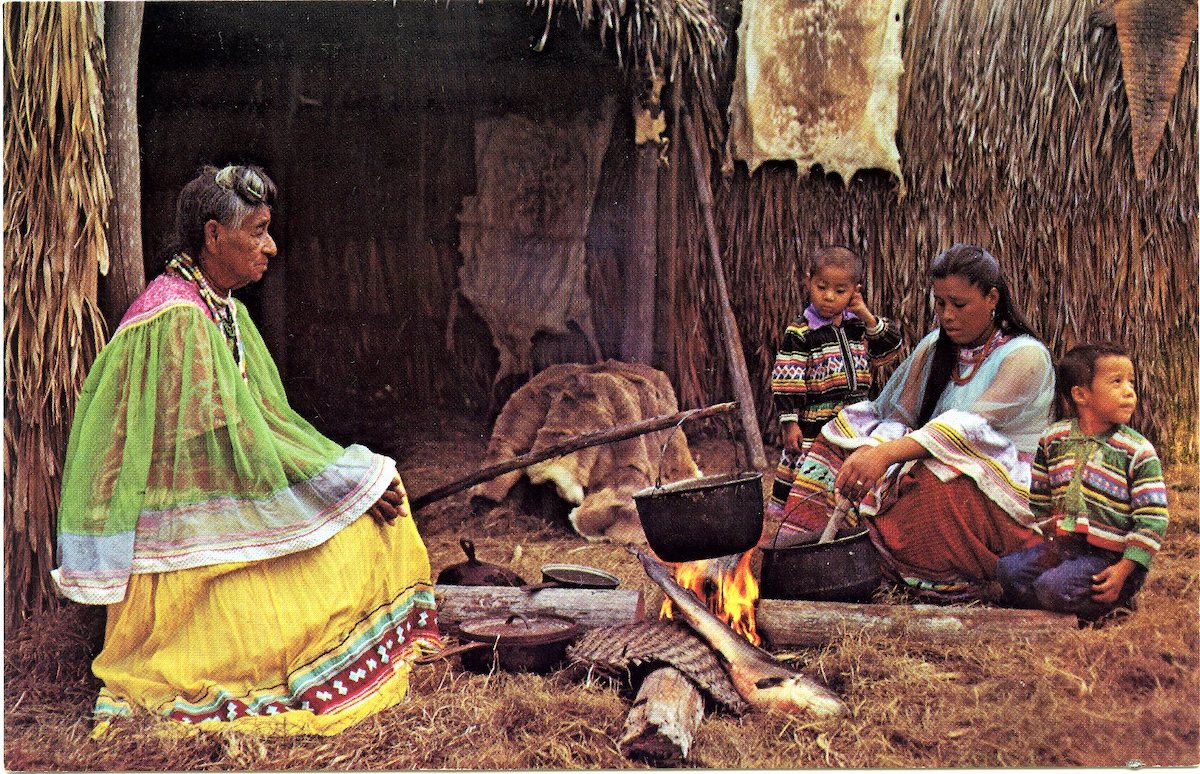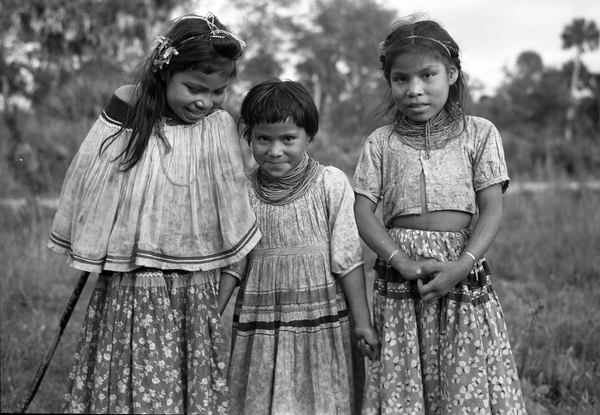
Seminole Snapshots: JJ Steinmetz’ Powerful Candid Camera
Welcome back to the latest installment in our Seminole Snapshots series. In this series, we look at the impact of photography in preserving and sharing the Seminole story. Previously, we have looked at the works of Julian Dimock, Irvin M. Peithmann, William Boehmer, and John Kunkel Small. This week, we focus on candid snapshots from renowned commercial photographer Joseph Janney Steinmetz. Over the years, Steinmetz snapped numerous shots of Seminoles, also including some important historic moments in history. So, follow along with us below to experience some of Steinmetz’ photographs, and for a peek into Seminole history!
In our featured image, you can see three young Seminole girls posing for a portrait. Steinmetz took the image on the Brighton Seminole Indian Reservation in 1948. Often, Steinmetz’ snaps are a mix of candids and portraits. Below, you can see a Seminole mother in a dugout canoe with her two sons. They are gigging for fish or frogs, somewhere near the Big Cypress Seminole Indian Reservation. Steinmetz snapped the shot on January 3, 1951.
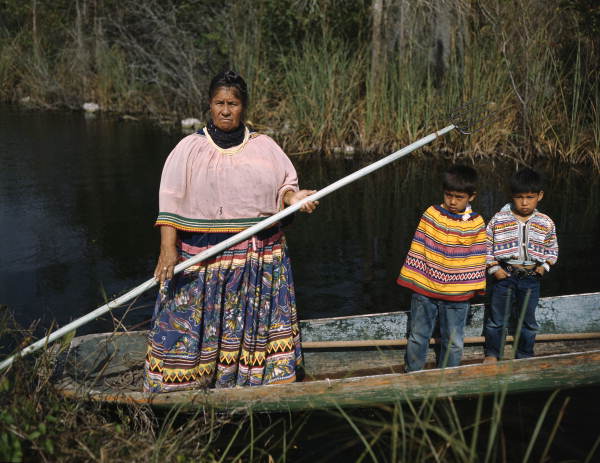
Lois and Joseph Janney Steinmetz
Born in Philadelphia in 1905, Steinmetz earned a degree in English from Princeton. His parents gave him a Leica camera in 1912, spurring a lifelong passion. Later stationed in Pensacola, Florida with the Navy during WWII, he “helped to develop innovative techniques for aerial reconnaissance photography.” Soon, Steinmetz became an acclaimed commercial photographer. His work was featured in numerous publications such as the Saturday Evening Post, Life, Look, Time, Holiday, Collier’s, and Town & Country.
Steinmetz moved to Sarasota in 1941. Interestingly, his work has been referred to as “’an American social history.” It documents diverse scenes of American life from affluent northeasterners to middle-class Floridians” (State Archives of Florida). Included in his work are prolific photos of the Ringling Brothers and Barnum & Bailey Circus, film sets, daily Floridian life, and commercial photography. A large facet of his photography included candid shots of Floridians living their lives. Thus, many of the photos that feature Seminoles are included in this.
Below, you can see Joseph Janney Steinmetz taking a photograph while on board a ship traveling to Guatemala in 1939. Lois Steinmetz, his wife, was also an accomplished photographer, and snapped the pic herself. The Steinmetz’ worked in tandem as a photography duo throughout their careers, soon opening a photography studio in Sarasota. Lois was incredibly involved in their photography studio, although her name has not received as much recognition or acclaim.
According to a 1962 Tampa Bay Times article, the pair “met at a Wyoming dude Ranch, got engaged in Paris, married in New York. They lived happily ever after and took many of the world’s most beautiful photographs” (17 Jun 1962, Tampa Bay Times). Soon, the Steinmetz’ had two children, Bill and Lois. Their daughter, Lois Duncan, was an acclaimed novelist, writer, poet, and journalist.

The Steinmetz Collection
The Steinmetz Collection was donated to the State Library and Archives of Florida on April 4, 2012. Then Secretary of State Ken Detzner stated “We are honored to display the photographs of someone as talented as Joseph Janney Steinmetz on the Florida Memory site. His work captured a diversity of scenes from different eras of our state and nation’s history that can be enjoyed by a diversity of audiences.” The collection, which contains more than 5,000 photographs, was donated by Steinmetz’ grandson, Brett Arquette. The importance of the collection can’t be understated. Thus, “Steinmetz’s images constitute a significant addition to the State Archives’ Florida Photographic Collection and enhance what is already considered the most complete visual history of Florida.”
Below, you can see the Steinmetz family packing for an assignment outside of their Sarasota studio in 1950.
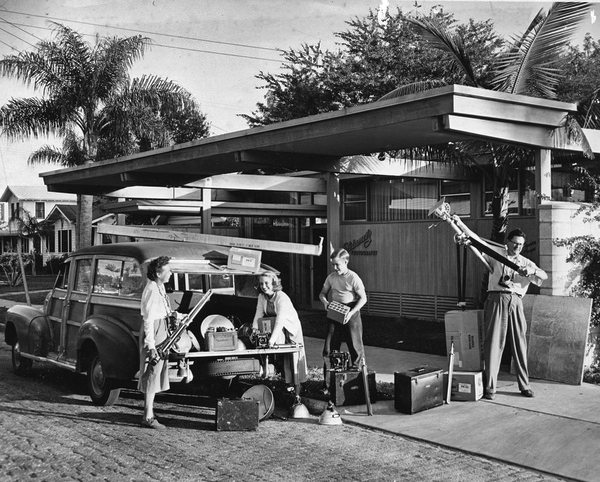
Wind Across the Everglades
Filmed in Everglades National Park in 1958, Wind Across the Everglades was loosely based on the life and death of game warden Guy Bradley during Florida’s Plume Wars. We have talked about the Plume Wars, and Wind Across the Everglades, in a previous blog post. Directed by Nicholas Ray, the film features not only glorious Florida landscapes, but an important look back at early 20th century conservation.
But, how does this relate to Steinmetz, or even Seminoles? During the filming of Wind Across the Everglades, Steinmetz took a number of behind-the-scenes candid shots of the actors, setting, and directing of the film. This includes candid shots of Cory Osceola, who was cast in the film as “Billy One-Arm.” In real life, Osceola has lost his arm in a train accident in 1922. Additionally, some of the film settings show places important to Seminole history. One such example is Smallwood’s Store, a trading post which is used as a backdrop in the film.
Osceola was an incredibly important leader to the Seminole people, and was considered the first Native American to purchase land in Collier County. Below, you can see Osceola talking with Nicholas Ray during the filming. Osceola’s daughter, Mary Moore Osceola, was also featured in the film in an uncredited role. Their family is still part of the Naples community.
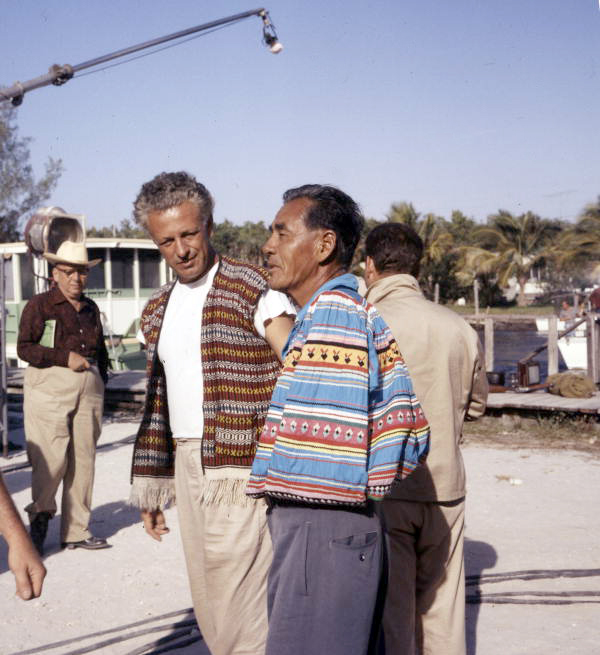
More of Steinmetz’ Images
Charlie Micco and Seminole Cattle
Below, Charlie Micco stands outside a cattle pen on the Brighton Seminole Indian reservation in 1949. Micco was one of the first elected cattle trustees for the Seminole Tribe and was instrumental in the Seminole cattle renaissance. He was also the first cattle foreman of the Tribe, and his personal camp was directly to the north of the Brighton Red Barn. Today, Micco’s camp is on the Tribal Register of Historic Places. You can learn more about Charlie Micco, Seminole cattle, and Red Barn in a previous blog post.
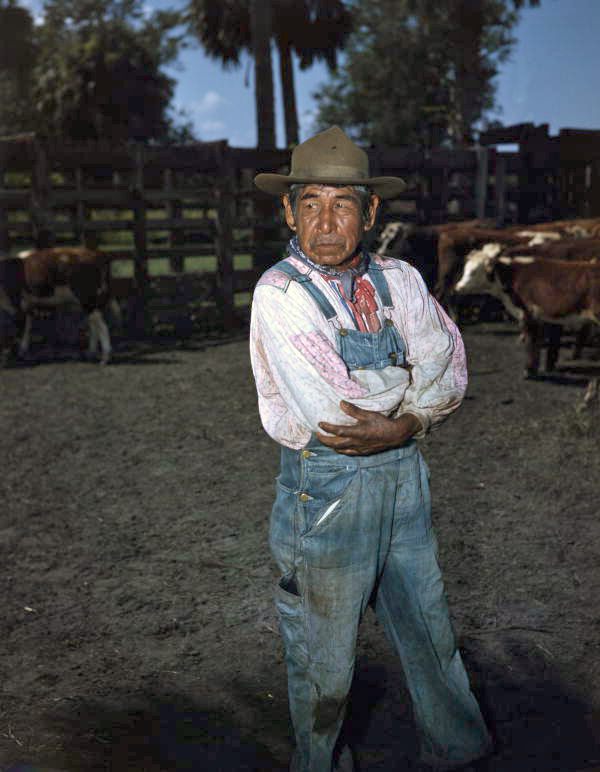
During Steinmetz’ time photographing Seminoles, the Seminole cattle industry was experiencing its resurgence. This pivotal point in Seminole history would support the Seminole Tribe for decades. Additionally, cattle continues to be an integral part of Seminole life today. Below, you can see a shot during round-up and branding of cattle.
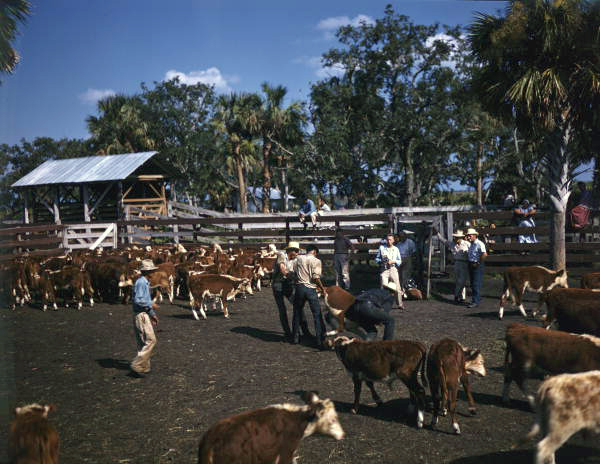
Candid Portraits
Steinmetz’ photography was often candid, but intimate portraits were also included in his collection. Below, you can see a posed portrait of Mrs. Lonnie Buck with her two children, Roly and Poly, on the Brighton Seminole Indian Reservation in 1949. There were three posed images in this series, with the children and their mother smiling and posing with each other on the red Radio Flyer that can be seen in the background.
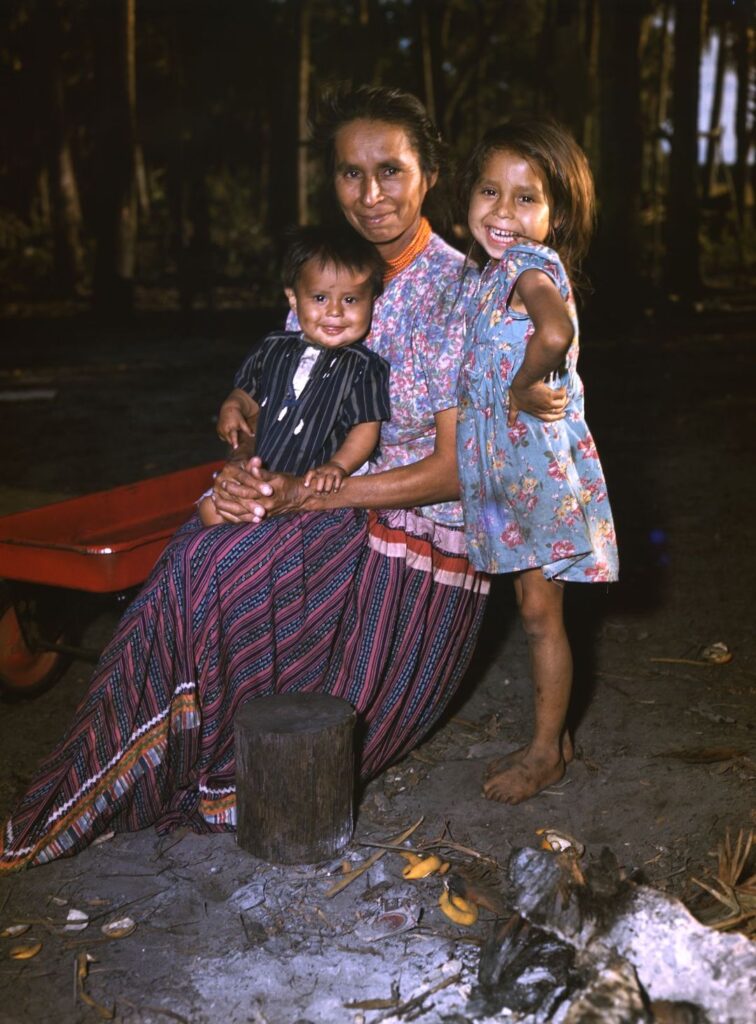
Her husband, Lonnie Buck, can be seen here smiling in the back of his work truck the same year.

Billy Bowlegs III
Billy Bowlegs III was also an important and influential Seminole elder. Below, an image taken my Steinmetz shows Bowlegs sitting on a fence post on the Brighton Seminole Indian Reservation in 1949. In his later years, Bowlegs was a constant presence at the Florida Folklife Festival, and shared traditional songs and dance. He is well-known for working hard to share the Seminole story and history. He lived to nearly 103 years old and was present for many eras of change for the Seminole people.
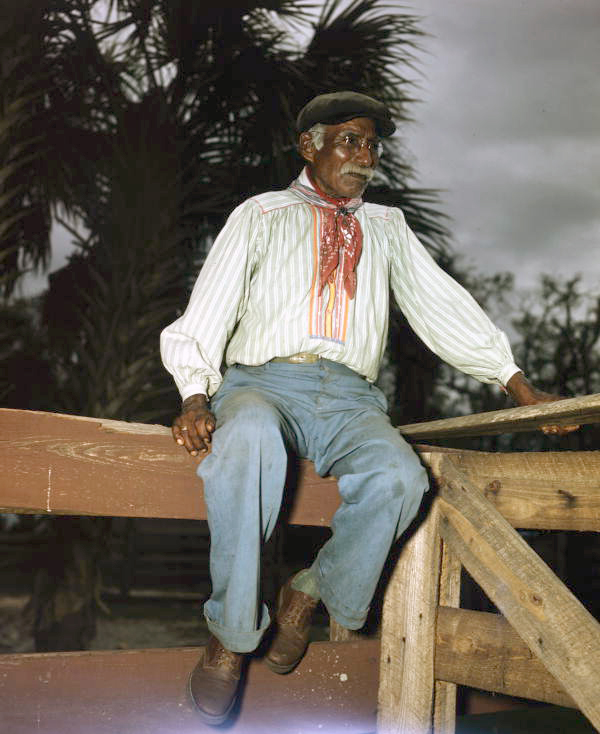
Day to Day Life
Here, a Seminole girl holds her little brother on the Brighton Seminole Indian Reservation in 1949. They are both wearing traditional clothing; she is wearing a skirt with beaded necklaces around her neck, and he is in a bigshirt.
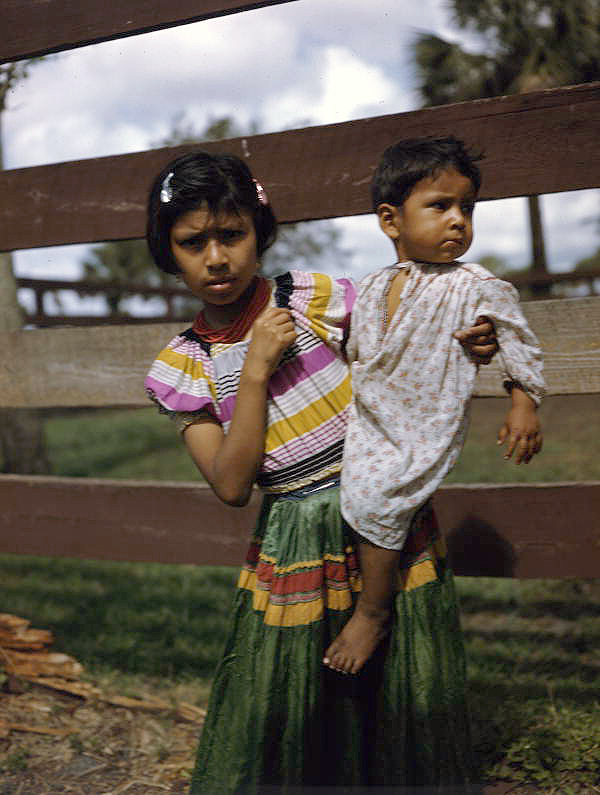
Many of Steinmetz’ images contain portraits of Seminole families and children going about their day-to-day life. Below, you can see an image of a Seminole family selling patchwork clothing to tourists by Lake Okeechobee on January 27, 1948. Tourist dollars supported many Seminole families during this period, and arts and crafts like patchwork, dolls, and other handmade items were sold at roadside tourist camps. Patchwork and other crafts remain incredibly important to the Seminole culture to this day, and skilled artisans dedicate many hours to crafting intricate designs. You can learn more about patchwork, as well as tourist camps, in some of our previous blog posts.
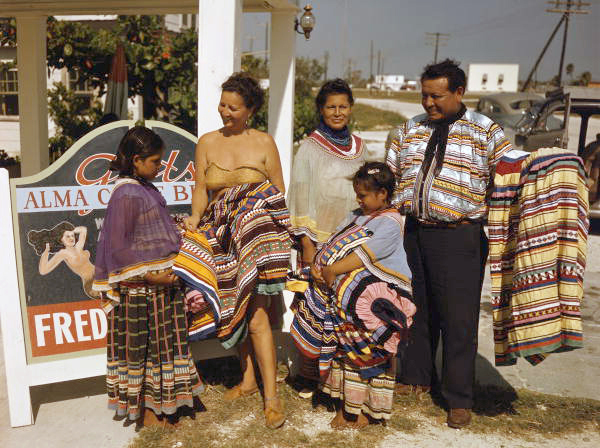
You can find Steinmetz’ full photographic collection on the Florida Memory Project, which is run by the State Archives of Florida. Looking for more historic images of Seminole history? Explore some of our other blog posts in the Seminole Snapshots series!
Author Bio
Originally from Washington state, Deanna Butler received her BA in Archaeological Sciences from the University of Washington in 2014. Deanna moved to Florida in 2016. Soon, she began working for the Seminole Tribe of Florida’s Tribal Historic Preservation Office. Deanna was the THPO’s Archaeological Collections Assistant from 2017-2021. While at the THPO, Deanna worked to preserve, support, and process the Tribe’s archaeological collection. She often wrote the popular Artifact of the Month series, and worked on many community and educational outreach programs. She lives in Lakeland, FL with her husband, two sons, and dog.



